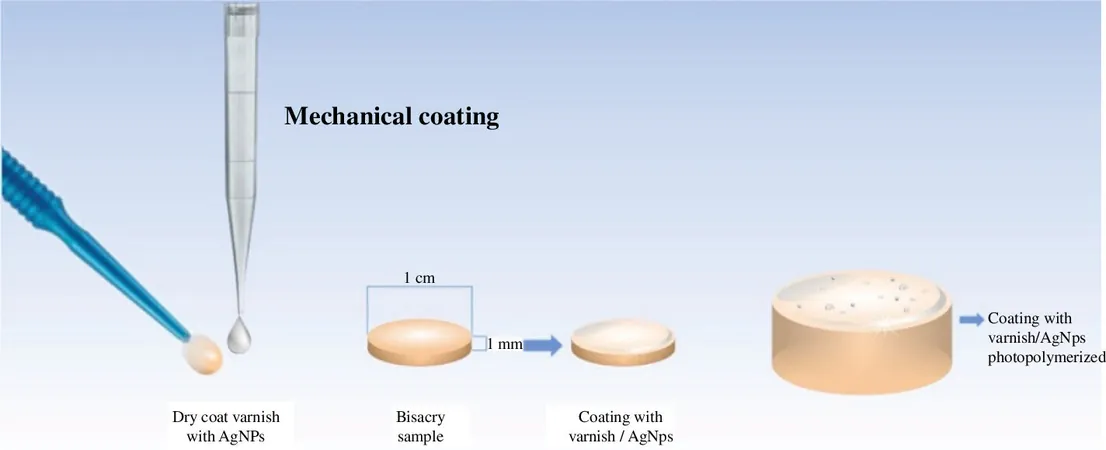
Revolutionary Silver Nanoparticle Resin Redefines Dental Hygiene: A Breakthrough in Dental Restorations!
2024-10-03
Author: Daniel
Introduction
The oral cavity is a bustling ecosystem teeming with microorganisms, which can exist in both healthy and diseased states. When it comes to dental restorations, using specialized materials is essential for patients to regain their dental structure, masticatory and phonetic functions, and to achieve improved aesthetics. However, one of the significant challenges faced in this field is the accumulation of bacteria on the surfaces of these materials.
Challenges of Bacterial Accumulation
Unfortunately, rough surfaces facilitate the adherence and growth of commensal microorganisms, forming biofilms that not only resist the oral environment but also can corrode the material over time. This corrosion can lead to unsightly structural and color changes, and more critically, it can result in infections like gingivitis or prosthetic stomatitis. To combat these issues, scientists are now focusing on self-hygienic properties in dental materials to prevent microbial colonization—vital for sustaining a healthy oral ecosystem.
The Role of Silver Nanoparticles
Enter silver nanoparticles (AgNPs), a game-changer in microbial management with their remarkable antimicrobial, optical, and electrical properties. These minuscule particles have found applications across various industries, including cosmetics, biomedicine, and packaging.
Innovative Research Findings
Recent groundbreaking research led by the Interdisciplinary Research Laboratory (LII) at ENES Leon, UNAM, has made headlines by developing a novel method to integrate AgNPs into the surfaces of composite resins used for provisional dental restorations. This innovation effectively suppresses bacterial growth, particularly among early colonizers within the oral cavity.
Expert Insights
According to Verónica Campos-Ibarra, a postdoctoral researcher at ENES Leon and a professor at the School of Stomatology, UASLP, “Our technique ensures that silver remains on the resin surface for an extended period, continuously releasing silver ions. This sustained release does not compromise the fibroblast cells assessed in our study, while simultaneously providing significant antiseptic activity in provisional restorations like bisacrylic resin.”
Practical Applications
Adding to this research, Ravichandran Manisekaran, a research professor and lab coordinator of Nanostructures and Biomaterials, noted that the study utilized a mechanical coating method with less than 0.03% silver concentration, executed using standard clinical equipment—making this approach both effective and practical.
Collaborative Effort and Future Implications
This pioneering study is part of a collaborative effort between ENES and UASLP, aiming to enhance prosthetic materials and contribute to the creation of nanostructure-modified medical devices specifically designed to prevent infections. This forward-thinking research promises to lower treatment costs and diminish infection rates, ultimately elevating the quality of life for patients.
Conclusion
Stay tuned as this innovative approach to dental hygiene continues to evolve, potentially transforming the landscape of dental restorations and patient care!



 Brasil (PT)
Brasil (PT)
 Canada (EN)
Canada (EN)
 Chile (ES)
Chile (ES)
 España (ES)
España (ES)
 France (FR)
France (FR)
 Hong Kong (EN)
Hong Kong (EN)
 Italia (IT)
Italia (IT)
 日本 (JA)
日本 (JA)
 Magyarország (HU)
Magyarország (HU)
 Norge (NO)
Norge (NO)
 Polska (PL)
Polska (PL)
 Schweiz (DE)
Schweiz (DE)
 Singapore (EN)
Singapore (EN)
 Sverige (SV)
Sverige (SV)
 Suomi (FI)
Suomi (FI)
 Türkiye (TR)
Türkiye (TR)